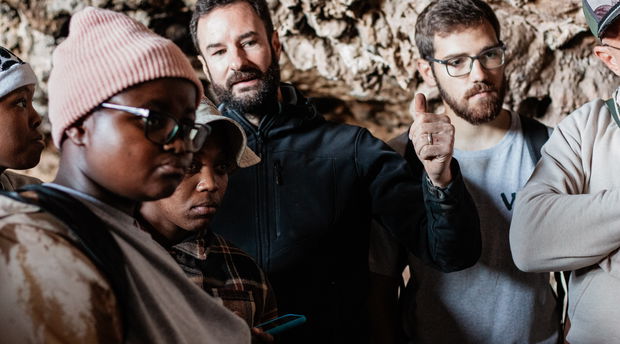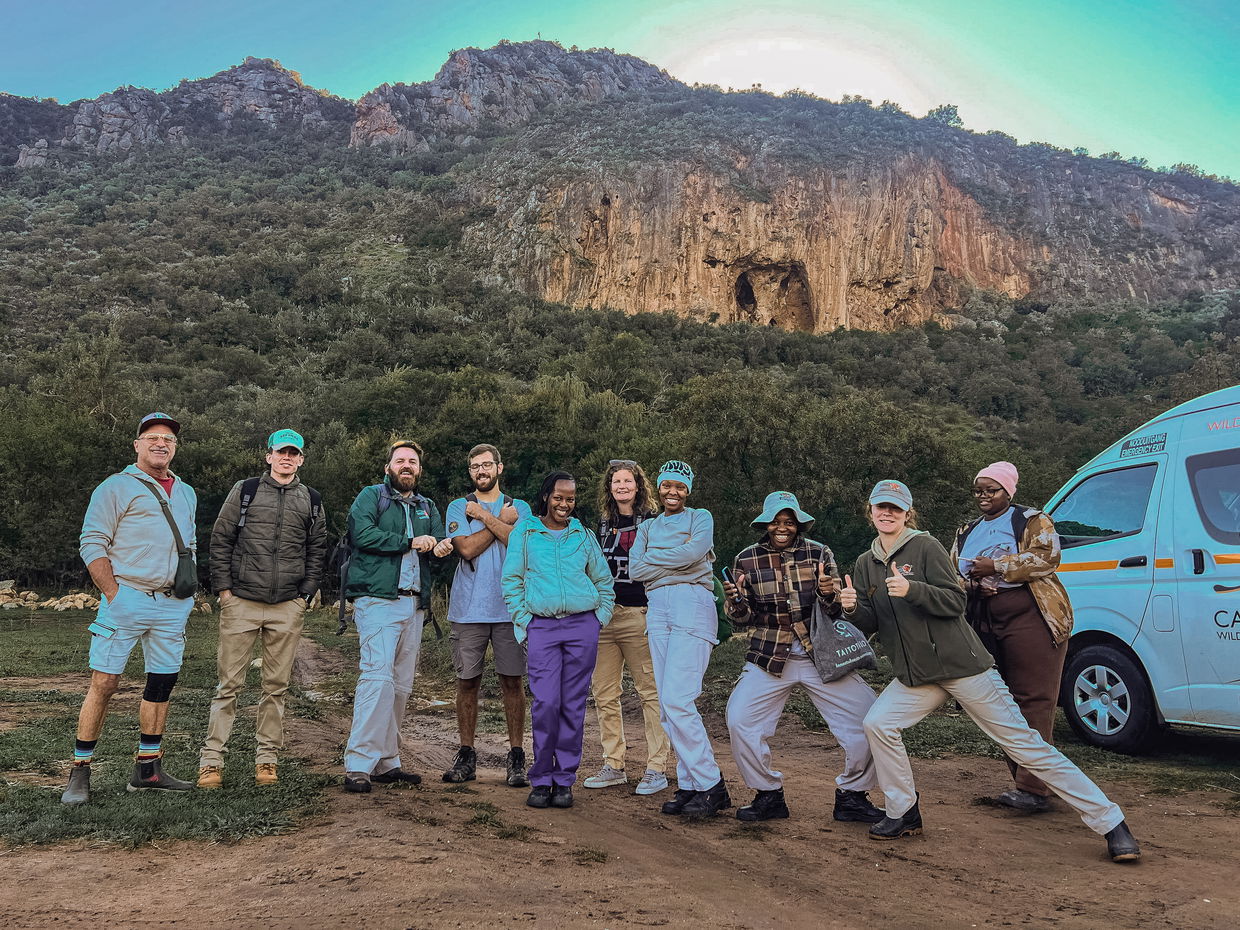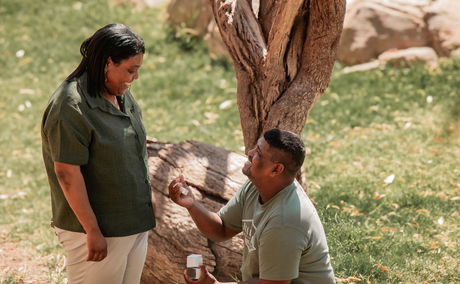Two travellers and their rescue dogs arrived in a truck the size of a tiny home. A day later, they were in our kitchens, spending time with our animals and sharing an unforgettable eye to eye moment with Jason the Nile Crocodile. Meet Susi and Kim. For most of their adult lives, their story looked familiar. Susi ran a large veterinary practice. She managed a team, handled emergencies and often slept four...
The Earth has a Story to Tell...

THE EARTH HAS A STORY TO TELL, AND FOSSILS ARE THE PAGES THAT REVEAL IT.
On the morning of Thursday, 22 May 2025, a rather eclectic band of adventurers set out from Oudtshoorn, bound for a site of prehistoric wonder hidden deep within the nearby Cango Valley: the legendary Boomplaas Cave.
Our troop included Tamryn Roux (WAV Host), Anneke Lategan (Marketing Manager), Sinead Hattingh (Heartbeat Adventures & Tours), two of our enthusiastic volunteers, Joseph Zwick (USA) and Keane Grieve (SA), our Nelson Mandela University (NMU) students Anele Phoswa, Asandiswa Magodla, Emihle Zuzo, Lindokuhle Lalendle, our sole NewBridge Graduate Institute (NGI) student, Andre Jacques du Plessis (AJ), and myself, Garret Eriksen.

Nestled just 7 km from the world famous Cango Caves, Boomplaas is currently buzzing with activity, thanks to the dedicated efforts of young archaeologists from South Africa and the USA, under the careful guidance of Dr Justin Pargeter, Assistant Professor of Anthropology at New York University (NYU). Our mission? To immerse ourselves in the fascinating work of the Cango Archaeology and Paleoscape Project (CAPP), a groundbreaking research initiative unearthing the captivating human story tucked within these ancient cave walls.

Now, as the Academic Programme Coordinator at Cango Wildlife Ranch, my objective is clear: to constantly hunt for enriching educational experiences that expand both minds and horizons. When I caught wind of an active archaeological dig happening in our backyard, nothing (short of a wild herd of prehistoric pachyderms) could have kept me away!
The drive was delightfully uneventful, though we quickly discovered Emihle’s newfound talent for singing on car journeys longer than five minutes — a skill she kindly demonstrated at full volume. Our navigation skills proved less harmonious, leading us to an incorrect farm where several puzzled farmworkers patiently redirected us. Eventually, we arrived at a nerve-wracking, rocky crossing submerged in shin-deep water. After a spirited debate, and with assurances that I'd shoulder the blame should our trusty Toyota bus become a permanent water feature, we bravely surged forward. Successfully across, our pride evaporated when we later learned the archaeologists effortlessly conquered this very obstacle twice daily in a Hyundai Staria — a van distinctly more suited to city streets than rugged streams.
 Feeling suitably humbled, we tackled the brisk, 15-minute uphill hike to Boomplaas Cave, discovering along the way just how embarrassingly unfit we all were (well except for Sinead, who regularly does 15 minute steep uphill climbs as minor warm-up). Upon arrival, we inadvertently interrupted Prof. Pargeter mid-project planning with his students, conveniently allowing us a few precious moments to catch our breath and absorb the awe-inspiring vistas of the Cango Valley.
Feeling suitably humbled, we tackled the brisk, 15-minute uphill hike to Boomplaas Cave, discovering along the way just how embarrassingly unfit we all were (well except for Sinead, who regularly does 15 minute steep uphill climbs as minor warm-up). Upon arrival, we inadvertently interrupted Prof. Pargeter mid-project planning with his students, conveniently allowing us a few precious moments to catch our breath and absorb the awe-inspiring vistas of the Cango Valley.
Once settled, we received an enlightening introduction from the professor, who enthusiastically explained the significance of Boomplaas Cave and the ambitious goals of CAPP, painstakingly paraphrased for you, dear reader, below:
“Boomplaas Cave is the Southern Cape’s only deep sequence inland archaeological site to preserve stratified Middle Stone Age and Later Stone Age deposits with rich botanical preservation. Excavated by the late Hilary Deacon between 1974 and 1979, Boomplaas is vital to understanding the archaeology and occupation history of Southern Africa because it is one of the rare inland sites occupied by humans across multiple climate cycles. It holds invaluable archives of cultural and environmental significance — lithics, ochre, ostrich eggshell, charcoal, pollen, micro and macro fauna, and paleobotanical materials. CAPP seeks to reopen excavations, generate fresh data about the region’s evolving paleohydrology, and integrate findings into a paleoscape model, enhancing our understanding of prehistoric human land-use strategies and southern Cape’s evolving inland socio-environmental systems.”
With our curiosity fully piqued, we stepped into the cave’s cool darkness and were greeted by an astonishing sight: a meticulously excavated five-metre pit plunging through layers of history, each centimetre a page from Earth’s ancient diary. Clearly visible were stripes of black, sooty earth — the remnants of countless ancient cooking fires — sandwiched between layers of reddish-brown soil, each colour narrating periods of human settlement and migration. Observing the careful excavation process, our students noted the immense patience required, as even a small mistake could disrupt invaluable fossil evidence. They marveled at how attention to detail, no matter how minute, could profoundly impact scientific outcomes.
Surrounding the excavation pit, a hive of activity unfolded. One CAPP student painstakingly peeled back history millimetre by millimetre, another catalogued tiny fragments of animal bones, and others calibrated sensitive electronic instruments, intent on extracting every possible clue from this prehistoric treasure trove. Our students were particularly intrigued by the artifacts found onsite, which vividly illustrate how life has evolved through the ages, offering tangible connections to our distant forebears.
Prof. Pargeter’s passionate lecture captivated us all. Its impact was profound, so much so that by the end, a few of my students jokingly debated how best to explain their newfound archaeological ambitions to their course supervisors back at NMU.
Why was such an experience valuable for our conservation-focused students and volunteers, you might ask? Because experiences like these enrich our understanding of the intricate links between archaeology and conservation — both fields share a vital goal of protecting culturally and ecologically significant landscapes, from fossil-rich ecosystems to ancient rock art sites. It was an excellent reminder that preserving biodiversity inherently safeguards irreplaceable archaeological heritage. Indeed, the shared presence of multiple industries and disciplines coming together in one place highlighted the interconnectedness and importance of collaboration in scientific exploration.
Our group left Boomplaas with a newfound respect for how deeply interconnected the scientific, environmental, and social disciplines truly are. Some students even discovered potential new career paths, inspired by the blend of meticulous science, storytelling through ancient art and artifacts, and the tangible evidence of human and ecological history.
Our enthusiasm was so infectious that we extended an invitation to Prof. Pargeter’s team to visit Cango Wildlife Ranch. Judging by their eager acceptance, it was clear that appreciation for each other's work now flowed strongly in both directions — a delightful outcome for any academic adventure.
A special thanks must be extended to Sinead Hattingh of Heartbeat Adventures & Tours, who not only arranged this unforgettable meeting with the CAPP team but also kindly shepherded us safely to the cave. And a heartfelt thank you to Prof. Pargeter and his brilliant students for welcoming us into their fascinating world — a remarkable intersection of science, history, and sheer human curiosity.
This article was written in part with contributions from our NMU and NGI students, who allowed me to shamelessly integrate their unique observations into our story.
Written by Dr Garrett Eriksen
Academic Programme Coordinator
Further Reading
Jade and Levinia met in the most unexpected way. Both attended the same church - he played the organ, and she was trying to leave early, and found her car blocked in by his. While he played, she waited. When she finally drove off, neither imagined that moment would change their lives.
Wild Animal Volunteers arrive with purpose. Their days begin with structure and intention as they join the team for morning duties. They help prepare specialised diets, assist with habitat care, support Animal Caregivers, and take part in the routines that keep our facility running smoothly. Every task is practical. Every action matters. Each moment contributes directly to animal welfare.
















Share This Post